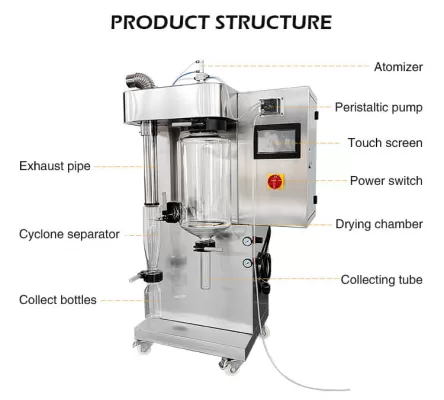A spray dryer is an industrial apparatus used for transforming liquid materials into powder or granular form, and its operational principle involves atomizing the liquid into tiny particles, followed by drying these particles through the exposure to hot air. Here is a detailed explanation of the working principle of a spray dryer:
1. **Feedstock**: The initial step in the process is introducing the liquid material to be processed into the spray dryer. These materials can be suspensions, emulsions, solutions, or suspended solids, usually prepared through a heating and mixing process.
2. **Atomization**: The feedstock is passed through a specialized sprayer, typically a high-speed centrifugal atomizer, where it is sprayed into fine particles or droplets. This process is called atomization. The design and parameters of the nozzle control the size and distribution of the particles.
3. **Drying Chamber**: The atomized particles enter the drying chamber. Inside this chamber, the particles are exposed to high-temperature hot air. Typically, the hot air is generated using gas or electric heating elements. The temperature of the hot air is usually higher than the boiling point of the liquid material, causing rapid evaporation.
4. **Evaporation and Drying**: The moisture within the droplets begins to evaporate, transitioning the particles from a liquid to a solid state. During this process, the moisture is quickly removed, progressively drying the particles. The high surface area of the fine particles generated by atomization leads to a rapid evaporation rate.
5. **Powder Collection**: The dried powder or granules are collected from the drying chamber. This often involves using airflow to direct the powder from the drying chamber to a dust collection device, such as a baghouse or cyclone separator.
6. **Gas Handling**: In addition to the powder, there is water vapor and residual substances in the hot air. These need further treatment for recovery or emissions. Typically, these gases are directed to a gas-handling system for cooling, filtration, and other processing methods.
7. **Finished Product**: The final product is in the form of powder or granules, with the desired particle size and physicochemical properties. These products can be used in various applications, such as food, pharmaceuticals, ceramics manufacturing, and more.
Spray Dryer Parameter
| Model | HF-2L |
| Air inlet temperature control | 30~300℃ |
| Air outlet temperature control | 30~150℃ |
| Electric heater power | 3KW AC220V |
| evaporation | 2000mL/H |
| Maximum feeding capacity | 2000mL/H |
| Fan power | 0.55KW |
| Maximum air volume | 5.6m³/min |
| Maximum air Pressure | 1020Pa |
| Air compressor power | 0.2KW |
| Nozzle diameter | 1.00mm |
| Operating Temperature | 10~40℃ |
| Dimension | 800 x 650 x 1300 ( mm ) |
| Weight | 125KG |

